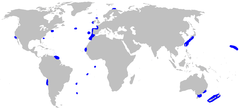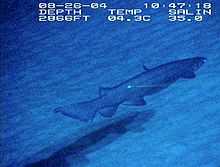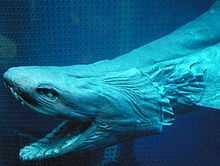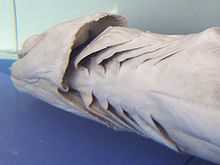Frilled shark
| Frilled shark | |
|---|---|
 | |
 | |
| Conservation status | |
| Scientific classification | |
| Kingdom: | Animalia |
| Phylum: | Chordata |
| Class: | Chondrichthyes |
| Subclass: | Elasmobranchii |
| Order: | Hexanchiformes |
| Family: | Chlamydoselachidae |
| Genus: | Chlamydoselachus |
| Species: | C. anguineus |
| Binomial name | |
| Chlamydoselachus anguineus Garman, 1884 | |
 | |
| Range of the frilled shark | |
The frilled shark (Chlamydoselachus anguineus) is one of two extant species of shark in the family Chlamydoselachidae, with a wide but patchy distribution in the Atlantic and Pacific Oceans. This rare species is found over the outer continental shelf and upper continental slope, generally near the bottom, though there is evidence of substantial upward movements. It has been caught as deep as 1,570 m (5,150 ft). In Suruga Bay, Japan it is most common at depths of 50–200 m (160–660 ft). Exhibiting several "primitive" features, the frilled shark has often been termed a "living fossil". It reaches a length of 2 m (6.6 ft) and has a dark brown, eel-like body with the dorsal, pelvic, and anal fins placed far back. Its common name comes from the frilly or fringed appearance of its six pairs of gill slits, with the first pair meeting across the throat.
Seldom observed, the frilled shark may capture prey by bending its body and lunging forward like a snake. The long, extremely flexible jaws enable it to swallow prey whole, while its many rows of small, needle-like teeth make it difficult for the prey to escape. It feeds mainly on cephalopods, leavened by bony fishes and other sharks. This species is aplacental viviparous: the embryos emerge from their egg capsules inside the mother's uterus where they survive primarily on yolk. The gestation period may be as long as three and a half years, the longest of any vertebrate. Litter sizes vary from two to fifteen, and there is no distinct breeding season. Frilled sharks are occasional bycatch in commercial fisheries but have little economic value. The International Union for Conservation of Nature (IUCN) has assessed it as Near Threatened, since even incidental catches may deplete its population given its low reproductive rate. This shark, or a supposed giant relative, is a suggested source for reports of sea serpents.
Taxonomy and phylogeny

The frilled shark was first scientifically recognized by German ichthyologist Ludwig Döderlein, who visited Japan between 1879 and 1881 and brought two specimens to Vienna. However, his manuscript describing the species was lost, and so the first description of the frill shark became authored by American zoologist Samuel Garman, working from a 1.5 m (4.9 ft) long female caught from Sagami Bay in Japan. His account, entitled "An Extraordinary Shark", was published in an 1884 volume of Proceedings of the Essex Institute.[2][3] Garman placed the new species in its own genus and family, and gave it the name Chlamydoselachus anguineus from the Greek chlamy ("frill") and selachus ("shark"), and the Latin anguineus for "snake-like".[4] Other common names for this species include frill shark, lizard shark, scaffold shark, and silk shark.[1][5]
Several early authors believed the frilled shark to be a living representative of otherwise long-extinct groups of elasmobranchs (sharks, rays, and their ancestors), based on its multi-pointed teeth, the articulation of its upper jaw directly to the cranium behind the eyes (called "amphistyly"), and its "notochord-like" spinal column with indistinct vertebrae.[6] Garman proposed that it was allied with the "cladodonts", a now-obsolete taxonomic grouping containing forms that thrived during the Palaeozoic era, such as Cladoselache from the Devonian period (416–359 Ma). His contemporaries Theodore Gill and Edward Drinker Cope suggested it was instead related to the hybodonts, which were the dominant sharks during the Mesozoic era. Cope went as far as to assign this species to the fossil genus Didymodus.[7][8]
More recent investigations have found that the similarities between the frilled shark and extinct groups may have been overstated or misinterpreted, and that this shark exhibits a number of skeletal and muscular traits that firmly place it with the neoselachians (modern sharks and rays), and more specifically with the cow sharks in the order Hexanchiformes (though systematist Shigeru Shirai has proposed that it be placed in its own order, Chlamydoselachiformes).[6][8] Nevertheless, the frilled shark belongs to one of the oldest still-extant shark lineages, dating back to at least the Late Cretaceous (c. 95 Ma) and possibly to the Late Jurassic (c. 150 Ma).[9] Because of its ancient ancestry and "primitive" characteristics, it has been described as a "living fossil".[3]
Distribution and habitat

Rather uncommon, the frilled shark has been recorded from a number of widely scattered locations in the Atlantic and Pacific Oceans. In the eastern Atlantic, it occurs off northern Norway, northern Scotland and western Ireland, from France to Morocco including Madeira, and off Mauritania.[10] In the central Atlantic, it has been caught at several locations along the Mid-Atlantic Ridge, from north of the Azores to the Rio Grande Rise off southern Brazil, as well as over the Vavilov Ridge off West Africa. In the western Atlantic, it has been reported from off New England, Georgia, and Suriname.[11][12][13] In the western Pacific, it is known from southeastern Honshu, Japan, to Taiwan, off New South Wales and Tasmania in Australia, and around New Zealand. In the central and eastern Pacific, it has been found off Hawaii, California, and northern Chile.[1][10] The frilled sharks off southern Africa were described as a different species, C. africana, in 2009.[13]
The frilled shark inhabits the outer continental shelf and upper to middle continental slope, seeming to favor upwellings and other biologically productive areas.[4] Though it has been caught from a depth of 1,570 m (5,150 ft), it usually does not occur deeper than 1,000 m (3,300 ft).[1][5] In Suruga Bay, it is most common at a depth of 50–200 m (160–660 ft), except from August to November when the temperature at the 100 m (330 ft) water layer exceeds 15 °C (59 °F) and the sharks shift into deeper water.[14][15] On rare occasions, this species has been seen at the surface.[10] The frilled shark is usually found close to the bottom, with one individual observed swimming over an area of small sand dunes.[1][11] However, its diet suggests that it does make substantial forays upward into open water.[16] This species may make vertical migrations, approaching the surface at night to feed.[4] There is spatial segregation by size and reproductive condition.[15]
Description


With its elongated, eel-like body and strange appearance, the frilled shark has long been likened to the mythical sea serpent. The head is broad and flattened with a short, rounded snout. The nostrils are vertical slits, separated into incurrent and excurrent openings by a leading flap of skin. The moderately large eyes are horizontally oval and lack nictitating membranes (protective third eyelids). The very long jaws are positioned terminally (at the end of the snout), as opposed to the underslung jaws of most sharks. The corners of the mouth are devoid of furrows or folds. The tooth rows are rather widely spaced, numbering 19–28 in the upper jaw and 21–29 in the lower jaw.[2][13] The teeth number around 300 in all; each tooth is small, with three slender, needle-like cusps alternating with two cusplets.[4][16] There are six pairs of long gill slits with a "frilly" appearance created by the extended tips of the gill filaments, giving this shark its name. The first pair of gill slits meet across the throat, forming a "collar".[2]
The pectoral fins are short and rounded. The single, small dorsal fin is positioned far back on the body, about opposite the anal fin, and has a rounded margin. The pelvic and anal fins are large, broad, and rounded, and also positioned well back on the body. The caudal fin is very long and roughly triangular, without a lower lobe or a ventral notch on the upper lobe. There are a pair of thick skin folds of unknown function running along the belly, separated by a groove.[2] The midsection is relatively longer in females than in males, with the pelvic fins pushed closer to the anal fin.[16][17] The dermal denticles are small and shaped like the tip of a chisel, becoming enlarged and sharp on the dorsal margin of the caudal fin.[2] This species is a uniform dark brown or gray.[4] The frilled shark differs from its southern African relative, C. africana, in having more vertebrae (160–171 vs 147) and more turns in the spiral valve intestine (35–49 versus 26–28), as well as in various proportional measurements such as a longer head and shorter gill slits.[13] The maximum known length is 1.7 m (5.6 ft) for males and 2.0 m (6.6 ft) for females.[4]
Biology and ecology
Highly specialized for life in the deep sea, the frilled shark has a reduced, poorly calcified skeleton and an enormous liver filled with low-density lipids, allowing it to maintain its position in the water column with little effort.[16] It is one of the few sharks with an "open" lateral line, in which the mechanoreceptive hair cells are positioned in grooves that are directly exposed to the surrounding seawater. This configuration is thought to be basal in sharks and may enhance its sensitivity to the minute movements of its prey.[16][18] Many frilled sharks are found with the tips of their tails missing, probably from predatory attacks by other shark species.[15] Parasites identified from this shark include a tapeworm in the genus Monorygma, the fluke Otodistomum veliporum,[19] and the nematode Mooleptus rabuka.[20]
Feeding
_by_OpenCage.jpg)
The long jaws of the frilled shark are highly distensible with an extremely wide gape, allowing it to swallow whole prey over one-half its size.[4] However, the length and articulation of its jaws means it cannot deliver as strong a bite as more conventionally built sharks.[21] Most captured individuals are found with no or barely identifiable stomach contents, suggesting a fast digestion rate and/or long intervals between feedings.[14] This species preys upon cephalopods, bony fishes, and smaller sharks.[4] One 1.6 m (5.2 ft) long individual, caught off Chōshi, was found to have swallowed a 590 g (1.30 lb) Japanese catshark (Apristurus japonicus).[16] Squid comprise some 60% of the diet of sharks in Suruga Bay; this includes not only slow-moving, deep-dwelling types such as Chiroteuthis and Histioteuthis, but also relatively large, powerful swimmers of the open ocean such as Onychoteuthis, Sthenoteuthis, and Todarodes.[14]
How the ostensibly weak-swimming frilled shark captures active, fast-moving squid is a matter of speculation. One possibility is that it takes advantage of injured squid, or those that are exhausted and dying after spawning.[14] Alternatively, it may surprise its prey by curving its body and, bracing itself with its posteriorly positioned fins, launching a quick strike forward in the manner of a snake. It may also be able to close its gill slits and create negative pressure to suck prey into its mouth.[16] The many small, sharp, recurved teeth of the frilled shark are functionally similar to squid jigs and could easily snag the body or tentacles of a squid, particularly as they are rotated outwards when the jaws are protruded. Observations of captive frilled sharks swimming with their mouths open suggest that the small teeth, light against the dark mouth, may even fool squid into attacking and entangling themselves.[13]
Life history
The frilled shark is aplacental viviparous; the developing embryos are mainly nourished by yolk, though the difference in weight between the egg and the newborn indicates that the mother also provides additional nutrition via unknown means. Adult females have two functional ovaries and one functional uterus, on the right. Unsurprisingly, there is no defined breeding season for either sex, as this shark inhabits depths at which there is little to no seasonal influence.[15] A possible mating aggregation of 15 male and 19 female sharks has been recorded over a seamount on the Mid-Atlantic Ridge.[12] The litter size ranges from two to fifteen, with an average of six.[4] Females ovulate eggs into the uterus about once every two weeks; vitellogenesis (yolk formation) and the growth of new ovarian eggs halt during pregnancy, apparently due to insufficient space inside the body cavity.[15]
Newly ovulated eggs and early-stage embryos are enclosed in a thin, ellipsoid, golden-brown capsule. When the embryo is 3 cm (1.2 in) long, the head is pointed when seen from above or below, the jaws are barely developed, the external gills have begun to appear, and all the fins are present. The egg capsule is shed when the embryo grows to 6–8 cm (2.4–3.1 in) long, and is expelled from the female's body; at this time the embryo's external gills are fully developed.[15][22] The size of the yolk sac remains mostly constant until around an embryonic length of 40 cm (16 in), whereupon it begins to shrink, mostly or completely disappearing by an embryonic length of 50 cm (20 in). The embryonic growth rate averages 1.4 cm (0.55 in) per month, and therefore the entire gestation period may last three and a half years, far longer than any other vertebrate.[15][16] Newborn sharks measure 40–60 cm (16–24 in) long; males attain sexual maturity at 1.0–1.2 m (3.3–3.9 ft) long, and females at 1.3–1.5 m (4.3–4.9 ft) long.[1]
Human interactions
The frilled shark has seldom been encountered alive, and thus poses no danger to humans (though scientists have accidentally cut themselves examining its teeth).[10] On August 27, 2004, the first observation of this species in its natural habitat was made by the ROV Johnson Sea Link II, on the Blake Plateau off the southeastern United States.[11] On January 21, 2007, a Japanese fisherman discovered a 1.6 m (5.2 ft) long female alive at the surface, perhaps there because of illness or weakness from the warm water. It was brought to Awashima Marine Park in Shizuoka, where it died after a few hours.[23] Garman, and numerous authors since, have advanced the frilled shark as an explanation for sea serpent sightings. Because of the shark's modest size, some cryptozoologists have posited the existence of a giant relative, particularly as larger Chlamydoselachus species are known from the fossil record.[2][3]
Small numbers of frill sharks are caught incidentally by various deepwater commercial fisheries around the world, using trawls, gillnets, and longlines.[1] In particular, it is regularly taken in Suruga Bay in bottom gillnets meant for sea breams and gnomefishes, and in midwater trawls meant for the shrimp Sergia lucens. Japanese fishers regard it as a nuisance, as it damages the nets.[15] This shark is sometimes sold for meat or processed into fishmeal, but is not economically significant. Because of its very low reproductive rate and the continuing expansion of commercial fisheries into its habitat, the International Union for Conservation of Nature (IUCN) has listed it as Near Threatened.[1]
References
- ↑ 1.0 1.1 1.2 1.3 1.4 1.5 1.6 1.7 Paul, L. and Fowler, S. (2003). "Chlamydoselachus anguineus". IUCN Red List of Threatened Species. Version 2010.1. International Union for Conservation of Nature. Retrieved April 25, 2010.
- ↑ 2.0 2.1 2.2 2.3 2.4 2.5 Garman, S. (January 17, 1884). "An Extraordinary Shark". Bulletin of the Essex Institute 16: 47–55.
- ↑ 3.0 3.1 3.2 Bright, M. (2000). The Private Life of Sharks: The Truth Behind the Myth. Stackpole Books. pp. 210–213. ISBN 0-8117-2875-7.
- ↑ 4.0 4.1 4.2 4.3 4.4 4.5 4.6 4.7 4.8 Ebert, D.A. (2003). Sharks, Rays, and Chimaeras of California. University of California Press. pp. 50–52. ISBN 0-520-23484-7.
- ↑ 5.0 5.1 Froese, Rainer and Pauly, Daniel, eds. (2010). "Chlamydoselachus anguineus" in FishBase. April 2010 version.
- ↑ 6.0 6.1 Compagno, L.J.V. (1977). "Phyletic Relationships of Living Sharks and Rays". American Zoologist 17 (2): 303–322.
- ↑ Garman, S. and Gill, T. (March 21, 1884). "'The Oldest Living Type of Vertebrata,' Chlamydoselachus". Science 3 (59): 345–346. doi:10.1126/science.ns-3.59.345-a. PMID 17838181.
- ↑ 8.0 8.1 Martin, R.A. Chlamydoselachiformes: Frilled Sharks. ReefQuest Centre for Shark Research. Retrieved on April 25, 2010.
- ↑ Martin, R.A. The Rise of Modern Sharks. ReefQuest Centre for Shark Research. Retrieved on April 25, 2010.
- ↑ 10.0 10.1 10.2 10.3 Compagno, L.J.V. (1984). Sharks of the World: An Annotated and Illustrated Catalogue of Shark Species Known to Date. Food and Agricultural Organization of the United Nations. pp. 14–15. ISBN 92-5-101384-5.
- ↑ 11.0 11.1 11.2 Jenner, J. (2004). Estuary to the Abyss: Excitement, Realities, and "Bubba". NOAA Ocean Explorer. Retrieved on April 25, 2010.
- ↑ 12.0 12.1 Kukuev, E.I. and Pavlov, V.P. (2008). "The First Case of Mass Catch of a Rare Frill Shark Chlamydoselachus anguineus over a Seamount of the Mid-Atlantic Ridge". Journal of Ichthyology 48 (8): 676–678. doi:10.1134/S0032945208080158.
- ↑ 13.0 13.1 13.2 13.3 13.4 Ebert, D.A. and Compagno, L.J.V. (2009). "Chlamydoselachus africana, a new species of frilled shark from southern Africa (Chondrichthyes, Hexanchiformes, Chlamydoselachidae)". Zootaxa 2173: 1–18.
- ↑ 14.0 14.1 14.2 14.3 Kubota, T., Shiobara, Y. and Kubodera, T. (January 1991). "Food habits of the frilled shark Chlamydoselachus anguineus collected from Suruga bay, central Japan". Nippon Suisan Gakkaishi 57 (1): 15–20.
- ↑ 15.0 15.1 15.2 15.3 15.4 15.5 15.6 15.7 Tanaka, S., Shiobara, Y., Hioki, S., Abe, H., Nishi, G., Yano, K. and Suzuki, K. (1990). "The reproductive biology of the frilled shark, Chlamydoselachus anguineus, from Suruga Bay, Japan". Japanese Journal of Ichthyology 37 (3): 273–291.
- ↑ 16.0 16.1 16.2 16.3 16.4 16.5 16.6 16.7 Martin, R.A. Deep Sea: Frilled Shark. ReefQuest Centre for Shark Research. Retrieved on April 25, 2010.
- ↑ Last, P.R. and J.D. Stevens (2009). Sharks and Rays of Australia (second ed.). Harvard University Press. pp. 34–35. ISBN 0-674-03411-2.
- ↑ Martin, R.A. Hearing and Vibration Detection. ReefQuest Centre for Shark Research. Retrieved on April 25, 2010.
- ↑ Collett, R. (1897). "On Chlamydoselacnus anguineus Garman. A remarkable shark found in Norway 1896". Christiania 11: 1–17.
- ↑ Machida, M., Ogawa, K. and Okiyama, M. (1982). "A new nematode (Spirurida, Physalopteridae) from frill shark of Japan". Bulletin of the National Science Museum Series A (Zoology) 8 (1): 1–5.
- ↑ Moss, S. (1977). "Feeding Mechanisms in Sharks". American Zoologist 17 (2): 355–364.
- ↑ Nishikawa, T. (1898). "Notes on some embryos of Chlamydoselachus anguineus, Garm.". Annotationes Zoologicae Japonenses 2: 95–102.
- ↑ Japanese Marine Park Captures Rare 'Living Fossil' Frilled Shark; Pictures of a Live Specimen 'Extremely Rare'. Underwatertimes.com. January 24, 2007. Retrieved on April 25, 2010.
External links
| Wikimedia Commons has media related to Frilled shark. |
- Chlamydoselachus anguineus, Frilled shark at FishBase
- Chlamydoselachus anguineus (Frilled Shark, Lizard Shark, Scaffold Shark) at IUCN Red List
- Deep Sea: Frilled Shark at ReefQuest Centre for Shark Research
| |||||||||||||||||||||
